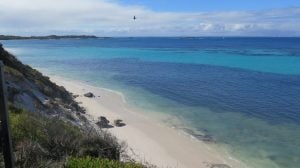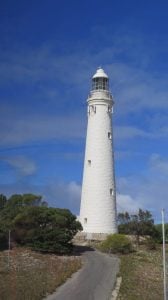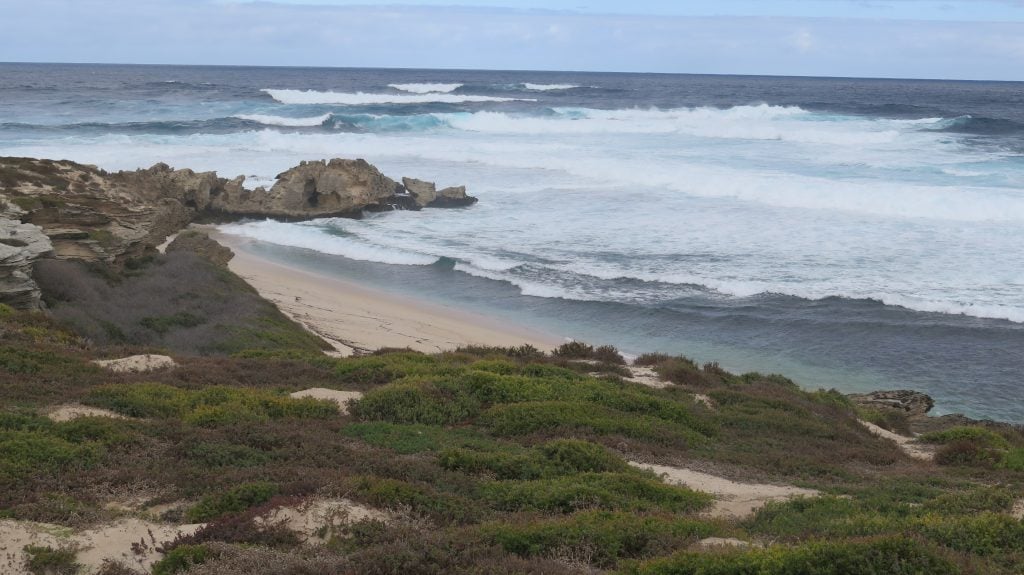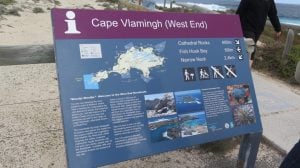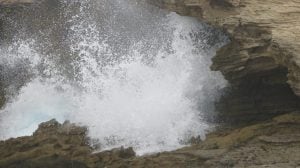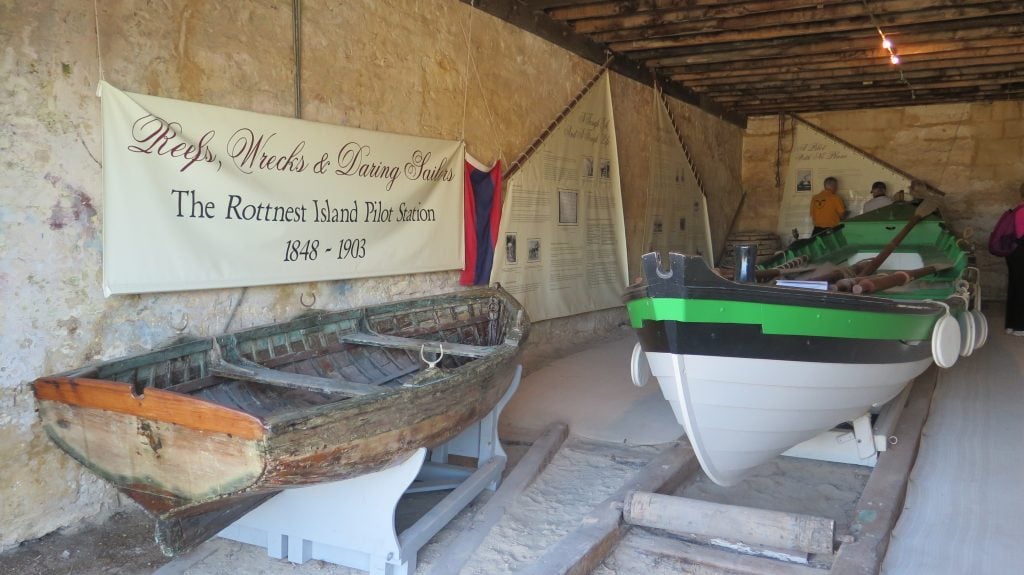14 May 2014
Our Rottnest Island ferry moored at the pier
We were all ready and waiting at 7.30am to be collected from our hotel for our ferry to Rottnest Island, leaving from the ferry wharves on the Swan River. Firstly we cruised along the Swan River, past some of the places we had visited such as Kings Park, and South Perth and then further south heading for Fremantle where we picked up more passengers. It was interesting that as well as the day trippers to the island, there were a number of people travelling to have a holiday on the island. The ferry took about an hour to reach Fremantle, then anther twenty five minutes to the Island. Here are some interesting facts about Rottnest Island :
- More than 500,000 people visit Rottnest Island each year.
- The Island is 11 kilometres long, 4.5 kilometres at its widest point, and the land area measures 1,900 hectares.
- It is a 24km ride around the Island. Allow at least 2.5 hours for a leisurely cycle.
- The Island is an ‘A’ Class Reserve managed by the Rottnest Island Authority.
- Each visitor to the Reserve pays an annual admission fee. These admission fees are included in the ferry fare, or as part of an annual admission fee for boat owners.
- Visitors can experience Aboriginal, European, colonial, maritime, military, recreational and social heritage on Rottnest Island, which to a certain extent is reflective of the development of the State of Western Australia.
-
The history of Rottnest Island has created a rich and significant cultural heritage. First records of human occupation of Rottnest Island are from more than 6,500 years ago when the Island was still attached to the mainland, and Aboriginal people inhabited the area. Since its initial European exploration from the 17th Century and its settlement in 1829, Rottnest Island has been through a number of stages of development and has been used for a variety of purposes.
You can read more about Rottnest Island here
Once we arrived on Rottnest we found our way to the tourist bus that would take us on a comprehensive tour of the places of interest. Initially we drove past the interesting salt lakes that have a higher salt content than the ocean (and in the early days were used to collect salt to trade), and the birds who are able to drink the salty water and the water life that survive in it.
Our first photo stop was Parker Point which is in a Sanctuary Zone. The rock formation was interesting, and the variations of blue in the water were amazing. The very light blue indicates a layer of white sand, and is where visitors moor their boats.
The white lighthouse was our next stop. It is the second lighthouse that was built on the island, when it was decided that the first lighthouse was not high enough. Views from the lighthouse across the dazzling white sands and blue water are truly beautiful.
Lighthouses played a key role in the pilot boat operations by providing a communication link between the pilot boat station and incoming ships. The Island’s first lighthouse was completed in 1851 and was constructed by Aboriginal prisoners, under the supervision of the Prison Superintendent. Half a century later it was replaced with a new, taller lighthouse on Wadjemup Hill; and a third was built in 1900 at Bathurst Point after the loss of 11 lives when the ship, the City of York, was wrecked in 1899. The Bathurst Point and Wadjemup Hill lighthouses remain today. The Wadjemup lighthouse was opened to the public on November 2nd, 2005, and tours are held daily.
The next stop for photo shoot was the dramatic Cape Vlamingh at the west end of the island. Here the Indian Ocean is wild, surf was spectacular, with waves crashing against the rocks. Cape Vlamingh is at the most western end of Rottnest Island. We could see a very large Osprey’s nest on one of the rocks, apparently these birds come back year after year to the same nests, adding more sticks on each occasion, so some of the nests can be huge. There was even a large active blowhole because of the heavy surf.
Our tour guide explained to us that the temperature of the water around Rottnest Island is warmer than the mainland, mainly due to the Leeuwen current that flows around the island. The water temperatures vary from 23 degrees in summer to 19 degrees in winter.
The quokka is possibly the most well known animal on Rottnest Island. It was first observed by a European in 1658 when the Dutchman, Volkersen, wrote that it resembled an Asian civet cat, but with brown hair. In 1696 de Vlamingh described the quokka as “a kind of rat as big as a common cat”. He named the Island ‘Rotte nest’ (meaning ‘rat’s nest’) and the name of the Island was eventually adapted to ‘Rottnest’. We were lucky to see quokkas (they are noctural) during our bus tour of the island, together with a wide variety of birds. The shearwaters were out fishing to feed their chicks, and in about 4 weeks time the shearwaters will migrate north. Around one of the salt lakes we also saw the tiny stilts who were fattening themselves in preparation for their pending migration to Russia – how these tiny birds manage to fly that far has to be one of the wonders of the world!
At the end of the bus tour it was time for lunch, so we found an outside table at a Dome restaurant, and while we were eating we were entertained by a cheeky tern, even a raven turned up no doubt looking for some scraps. It was peaceful and relaxing looking out over the water.
We still had some spare time before the ferry would return us to Perth, so we walked along the waterfront to find that the Pilot Station museum was still open. Two boats are housed in what was the original pilot station together with informative posters and memorabilia.
A secure boathouse, established in 1846, was the first building constructed for the pilot service. This was built at the northern end of the seawall. Six years later, quarters for the pilot crew were added to the top of the boathouse. In 1859 another boathouse was built and still remains today. The last pilot left Rottnest Island in 1903, ending more than 55 years of piloting, and a new system was established with a signal station set up near Bathurst Lighthouse for the Fremantle Harbour Trust. It was dismantled in 1904 and then erected near Wadjemup lighthouse. Once a vessel was sighted, the news was telephoned to the lighthouse in Fremantle and the new, steam-powered pilot boat dispatched from there. The signal station remained in operation until 1949 when compulsory pilotage was abolished, effectively making the signal station on Rottnest Island redundant. The signal station was restored in 2002 and is now maintained and manned by volunteers.
Then it was time to amble back to the pier to board the ferry for the return to Perth, again via Fremantle. The crossing was much smoother than the morning, which pleased me (I am prone to seasickness). As we drew close to Perth the evening was closing in, and the lights around the whole of the Swan River looked spectacular – what a great finish to a wonderful day on Rottnest Island.
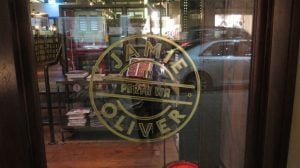 We didn’t feel like food until later in the evening, and decided to try out Jamie Oliver’s Italian restaurant around the corner from our hotel. Luckily we did not have to wait long for a table. It was very crowded (I think it is most times) and very noisy, however the food was delicious and the service top class. We had a small assortment of breads, I had Prawn Linguine with Panna Cotta for dessert, and Pete ordered Lamb Ravioli followed by Affogato. With a glass of red wine the meal completed a wonderful day.
We didn’t feel like food until later in the evening, and decided to try out Jamie Oliver’s Italian restaurant around the corner from our hotel. Luckily we did not have to wait long for a table. It was very crowded (I think it is most times) and very noisy, however the food was delicious and the service top class. We had a small assortment of breads, I had Prawn Linguine with Panna Cotta for dessert, and Pete ordered Lamb Ravioli followed by Affogato. With a glass of red wine the meal completed a wonderful day.
Over the next few days we head west to Merredin, the capital of the wheat area, then to Hyden and Wave Rock, before returning to the west coast at Bunbury and the start of our journey around the south west corner. Sounds exciting!




